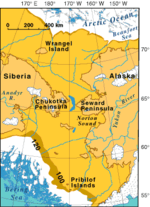Ancient Beringian
- This is about the genetic lineage associated with the peopling of the Americas. For the archaeogenetics of the USR population, see Upward Sun River site#Archaeogenetics.

The Ancient Beringians (AB) is the name given to a specific archaeogenetic lineage, based on the genome of an infant found at the Upward Sun River site (dubbed USR1), dated to 11,500 years ago.[1] The AB lineage diverged from the Ancestral Native American (ANA) lineage about 20,000 years ago. The ANA lineage was estimated as having been formed between 20,000 and 25,000 years ago by a mixture of Proto-Mongoloid and Ancient North Eurasian lineages, consistent with the model of the peopling of the Americas via Beringia during the Last Glacial Maximum.[2] The Ancient Beringian lineage is extinct, and is not found as a contribution to modern indigenoous lineages in Alaska. The 2018 study suggests that the AB lineage was replaced by or absorbed in a back-migration of NNA to Alaska. The modern Athabaskan populations are derived from an admixture of this NNA back-migration and a Paleo-Siberian (Early Paleo-Eskimo) lineage before about 2,500 years ago.[3]
The discovery was made from archaeogenetic analyses on the remains of two female infants discovered in 2013 at the Upward Sun River site (USR).[1] The USR site is affiliated with the Denali Complex, a dispersed archaeological culture of the American Arctic. The genomic analysis of nuclear DNA of the older of the two infants (USR1) was done at the Centre for Geogenetics at the University of Copenhagen's Natural History Museum of Denmark. Results from the team's genetic analysis were published in January 2018 in the scientific journal Nature. The analysis compared the infant's genomes with both ancient and contemporary genomes. The results suggested that the pre-"Ancestral Native American" lineage derived from the proto-Mongoloid lineage after 36 kya, with gene flow until about 25 kya. During 25–20 kya, this lineage was substantially mixed with the Ancient North Eurasian lineage, to form the "Ancestral Native American" lineage by 20 kya. The "Ancient Beringian" (AB) lineage derived from ANA and persisted without significant admixture in Alaska until the time of USR1, some 8,000 years later. The lineage of other Paleo-Indians diverged form AB at ca. 20–18 kya, and further divided into "North Native American" (NNA) and "South Native American" lineages between 17.5 kya and 14.6 kya, reflecting the dispersal associated with the early peopling of the Americas.[1]
See also
References
- 1 2 3 "Terminal Pleistocene Alaskan genome reveals first founding population of Native Americans", Nature, Macmillan Publishers Limited, retrieved January 3, 2018
- ↑
Confidence intervals given in Moreno-Mayar et al. (2018):
- 26.1-23-9 kya for the separation of the East Asian lineage of ANA from modern East Asian populations;
- 25-20 kya for the admixture event of ANE and early East Asian lineages ancestral to ANA;
- 22.0-18.1 kya for the separation of Ancient Beringian from other Paleo-Indian lineages;
- 17.5-14.6 kya for the separation of Paleo Indian into North Native Americans (NNA) and South Native Americans (SNA).
- ↑ Moreno-Mayar et al. (2018), fig. 3; Supplementary Material p. 37. "While the population represented by USR1 most likely occupied interior Alaska at least until 11.5 kya 74 (the age of USR1), it is present-day Na-Dene-speakers who presently occupy the region. Coupled with the geographic distribution of the Na-Dene language family, results showing that USR1 does not carry the Asian-derived ancestry component indicate that such ancestry entered the Americas after 11.5 kya [...] Altogether, these results indicate that the admixture event that gave rise to most Na-Dene-speakers, between NNA and a Siberian population occurred well after 11.5 kya and at least prior to ~2.5 kya (the age of individual 302)."
- Potter, Ben A.; Irish, Joel D.; Reuther, Joshua D.; Gelvin-Reymiller, Carol; Holliday, Vance T. (Feb 25, 2011). "A Terminal Pleistocene Child Cremation and Residential Structure from Eastern Beringia". Science. 331 (6020): 1058–1062. Bibcode:2011Sci...331.1058P. doi:10.1126/science.1201581. PMID 21350175.
- Potter, Ben A.; Irish, Joel (December 2, 2014). "New insights into Eastern Beringian mortuary behavior: A terminal Pleistocene double infant burial at Upward Sun River". PNAS. 111 (48): 17060–17065. Bibcode:2014PNAS..11117060P. doi:10.1073/pnas.1413131111. PMC 4260572.
- Price, Michael (January 3, 2018), "Ancient Americans arrived in a single wave, Alaskan infant's genome suggests", Science, American Association for the Advancement of Science, Vol 359, Issue 6371
External links
- Amos, Jonathan (January 3, 2018), "Alaskan infant's DNA tells story of 'first Americans'", BBC
- Ancient Beringians, Dr. Ben A. Potter, retrieved January 7, 2018 </ref>
- Thompson, Helen (November 10, 2014). "Ice Age Babies Surrounded by Weapon Parts Found in Alaska". Smithsonian. Retrieved January 7, 2018.